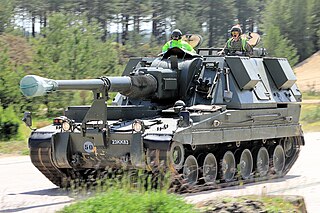
The AS-90, known officially as Gun Equipment 155 mm L131, is an armoured self-propelled artillery used by the British Army.

The 105 mm Howitzer Motor Carriage M7 was an American self-propelled gun vehicle produced during World War II. It was given the official service name 105 mm Self Propelled Gun, Priest by the British Army, due to the pulpit-like machine gun ring, and following on from the Bishop and the contemporary Deacon self-propelled guns.

FV433, 105mm, Field Artillery, Self-Propelled "Abbot" is the self-propelled artillery, or more specifically self-propelled gun (SPG), variant of the British Army FV430 series of armoured fighting vehicles (AFVs), using much of the chassis of the FV430 but with a fully rotating turret at the rear housing the 105 mm gun and given the vehicle designation of FV433.
OTO Melara was a subsidiary of the Italian company Finmeccanica, today Leonardo, active in the defence sector, with factories in Brescia and La Spezia. The Mod 56 pack howitzer, in service throughout the world, and the 76mm naval gun, adopted by 53 navies and installed on over 1,000 naval vessels, are among OTO Melara's best known weapons since World War II.

The L118 light gun is a 105 mm towed howitzer. It was originally designed and produced in the United Kingdom for the British Army in the 1970s. It has since been widely exported. The L119 and the United States Army's M119 are variants that use a different type of ammunition.
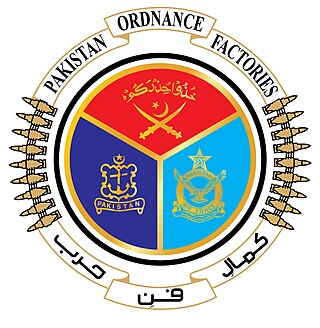
The Pakistan Ordnance Factories (POF) is a major firearms and a defence contractor headquartered in Wah Cantt, Punjab, Pakistan. Described as "the largest defence industrial complex under the Ministry of Defence Production, producing conventional arms and ammunition to the international standards" by the Government of Pakistan.
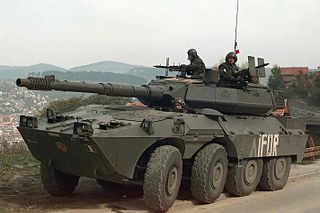
The Centauro is a family of Italian military vehicles originating from a wheeled tank destroyer for light to medium territorial defense and tactical reconnaissance. It was developed by a consortium of manufacturers, the Società Consortile Iveco Fiat - OTO Melara (CIO). Iveco Fiat was tasked with developing the hull and propulsion systems while Oto Melara was responsible for developing the turrets and weapon systems.

The M108 Howitzer is an American self-propelled 105 mm howitzer, first introduced in the early 1960s as a replacement for the M52 self-propelled howitzer.

Fälthaubits 77 or FH77 is a Swedish 155 mm howitzer, developed and manufactured by Bofors. It is also colloquially known as the Bofors gun in India. There were several versions, the original with a 38 calibre barrel and sliding block mechanism, the export version FH77 B version with a 39 calibre barrel and an interrupted ogival screw breech. For the demonstrator of the Archer Artillery System, some FH77A were modified into FH 77 AD L/45, while the series production were FH77Bs rebuilt into FH77 BW L/52. The carriage was also used for the "12 cm rörlig kustartilleripjäs m/80 KARIN", used in the Swedish coastal artillery.

The 105 mm Howitzer M3 was a U.S. light howitzer designed for use by airborne troops. The gun utilized the barrel of the 105 mm Howitzer M2, shortened and fitted to a slightly modified split trail carriage of the 75 mm pack howitzer.
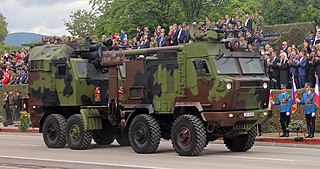
The Nora B-52 is a 155 mm self-propelled howitzer developed by Military Technical Institute and manufactured by Yugoimport SDPR in Velika Plana, Serbia.

The Rocket Forces and Artillery of the Ukrainian Ground Forces consist of units armed with tactical missiles, howitzers, cannons, mortars, jet-propelled and anti-tank artillery. They are tasked to destroy human resources, tanks, artillery, anti-tank weapons, aircraft, air defense and other important installations operations.
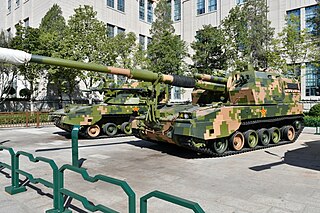
The PLZ-05 or the Type 05 is a 155 mm self-propelled howitzer developed by the People's Liberation Army of China to replace the Type 59-1 130 mm towed gun and Type 83 152 mm self-propelled gun. The PLZ-05 was officially unveiled at the Military Museum of the Chinese People's Revolution to mark the 80th anniversary of the PLA in July 2007, and first entered service with the PLA in 2008.

155mm (6.1in) is a NATO-standard artillery shell caliber that is used in many field guns, howitzers, and gun-howitzers. It is defined in AOP-29 part 1 with reference to STANAG 4425.
OFB 105mm SPG is an Indian self-propelled tracked artillery. It has been developed & manufactured by Ordnance Development Centre, Ordnance Factory Medak. This is developed from Light Field Gun mounted on BMP 2 Sarath

The 155 mm Howitzer Motor Carriage M41 was an American self-propelled artillery vehicle built on a lengthened M24 Chaffee tank chassis that was introduced at the end of the Second World War. Out of a planned run of 250, only 85 were produced before cancellation of the order at the end of 1945. The M41 went on to serve extensively in the Korean War, its success influencing the design of later U.S. self-propelled artillery. The type was retired after the conclusion of that conflict but went on to serve briefly in the French Army.
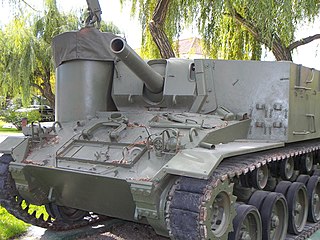
The M37 105 mm Howitzer Motor Carriage is a 105 mm howitzer self propelled gun developed by the United States. It saw combat in the Korean War and remained part of the U.S. military until being replaced in the late 1950s. Approximately 300 were built.
This article lists the structure of the Royal Danish Army in 1989 and in May 2020:














